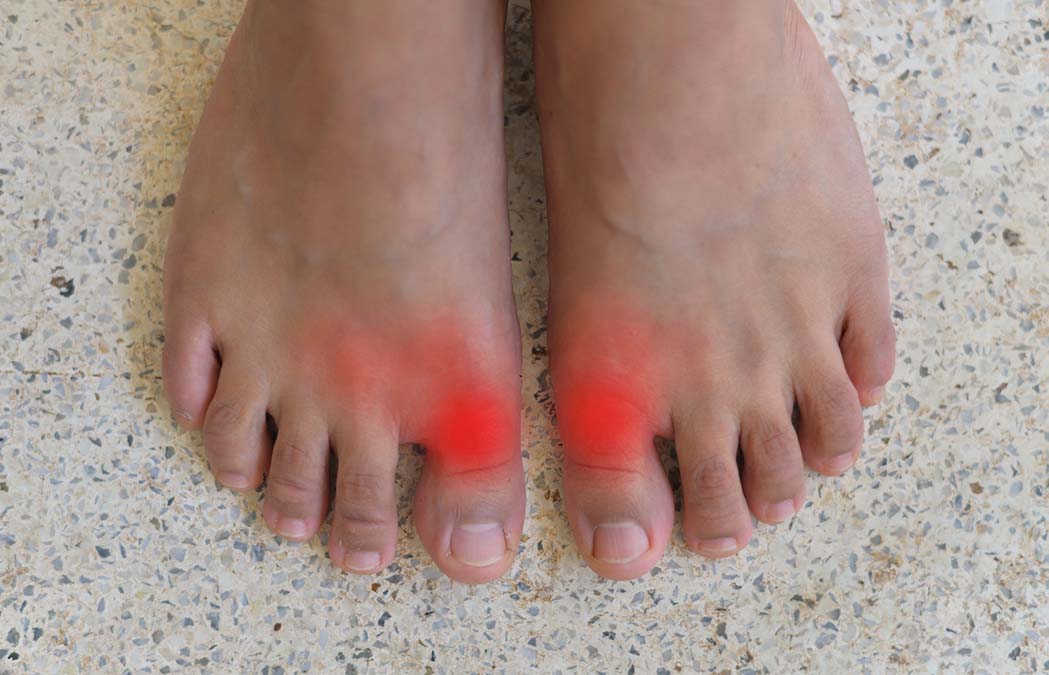 Gout typically affects more men than women; a lot more.
Gout typically affects more men than women; a lot more.
In fact, women make up only 5.1 percent of American gout sufferers, and any time a researcher stumbles across a difference of that magnitude, it makes them wonder what caused it.
In this case they wondered if there were different risk factors at play for men and women.
They conducted their research and published their results in the journal Advances in Rheumatology.
Digging through the largest medical journal databases turned up 33 articles, 20 of which compared the risk factors for men and women directly. A further 10 used only males as subjects and three used only women.
The most commonly identified risk factors found in the literature were things like age, ethnicity, the DASH diet (used to prevent high blood pressure), the metabolic syndrome and diabetes, body mass index, waist and chest circumference, waist-to-hip ratio, weight changes, cholesterol and blood fats, high blood pressure, renal disease, psoriasis or psoriatic arthritis, the use of diuretics or antidiabetic drugs, and the consumption of various foods and beverages like alcohol, coffee, meat, seafood, dairy, fructose, asparagus, spinach, cauliflower, mushrooms, and other purine-rich vegetables.
In general, the scientists found that the risk factors did not differ between men and women, with only two exceptions:
1. Men were more likely than women were to develop gout as a result of the metabolic syndrome.
2. Women were more likely than men were to develop gout after consuming fish and shellfish.
This may partly answer the question as to why more men than women have gout.
Thanks to all the unhealthy foods we have access to these days and a general lack of exercise, the metabolic syndrome is widespread and becoming more so all the time. So, preventing it will certainly help.
In general, the risk factors from the literature included:
1. Older age.
2. The fact that gout is more common in African than in Caucasian Americans.
3. High fructose and sugar consumption promote gout.
4. Heavy alcohol consumption.
5. The metabolic syndrome in men, and a weak risk associated with diabetes, but also mostly for men.
6. High body-mass index.
7. High waist-to-hip ratio.
8. Weight changes.
9. A weak risk associated with high cholesterol or blood fats, but mostly in postmenopausal women.
10. Renal insufficiency or failure.
11. High blood pressure.
12. Psoriasis or psoriatic arthritis.
13. Diuretic use.
From this review, coffee seems to be a protective factor against gout.
The sources from which you acquire your proteins don’t seem to be a risk or protective factor, except for fish and shellfish in women. Neither, surprisingly, is high waist and chest circumference.
So, to avoid gout, adopt a lifestyle that protects you against the metabolic syndrome (especially if you’re male) and take the other risk factors seriously too.

 Overcoming IBD
Overcoming IBD Multiple Sclerosis
Multiple Sclerosis Banishing Bronchitis
Banishing Bronchitis Gum Disease Gone
Gum Disease Gone Overcoming Onychomycosis
Overcoming Onychomycosis Neuropathy No More
Neuropathy No More The Prostate Protocol
The Prostate Protocol Brain Booster
Brain Booster
 Ironbound
Ironbound
 Solution for Shingles
Solution for Shingles
 The Bone Density Solution
The Bone Density Solution
 The Ultimate Healing Protocol
The Ultimate Healing Protocol
 The Parkinson's Protocol
The Parkinson's Protocol
 The Chronic Kidney Disease Solution
The Chronic Kidney Disease Solution
 Overthrowing Anxiety
Overthrowing Anxiety The Fatty Liver Solution
The Fatty Liver Solution The Hypothyroidism Solution
The Hypothyroidism Solution
 The End of Gout
The End of Gout The Blood Pressure Program
The Blood Pressure Program
 The Oxigized Cholesterol Strategy
The Oxigized Cholesterol Strategy
 Stop Snoring And Sleep Apnea Program
Stop Snoring And Sleep Apnea Program
 The Arthritis Strategy
The Arthritis Strategy The Vertigo & Dizziness Program
The Vertigo & Dizziness Program The 3-Step Diabetes Strategy
The 3-Step Diabetes Strategy Hemorrhoids Healing Protocol
Hemorrhoids Healing Protocol The Erectile Dysfunction Master
The Erectile Dysfunction Master Weight Loss Breeze
Weight Loss Breeze The IBS Program
The IBS Program The Insomnia Program
The Insomnia Program The Migraine and Headache Program
The Migraine and Headache Program The Neck Pain Solution
The Neck Pain Solution The Menopause Solution
The Menopause Solution The Ejaculation Master
The Ejaculation Master The TMJ Solution
The TMJ Solution The Acid Reflux Solution
The Acid Reflux Solution The Fibromyalgia Solution
The Fibromyalgia Solution The Psoriasis Strategy
The Psoriasis Strategy